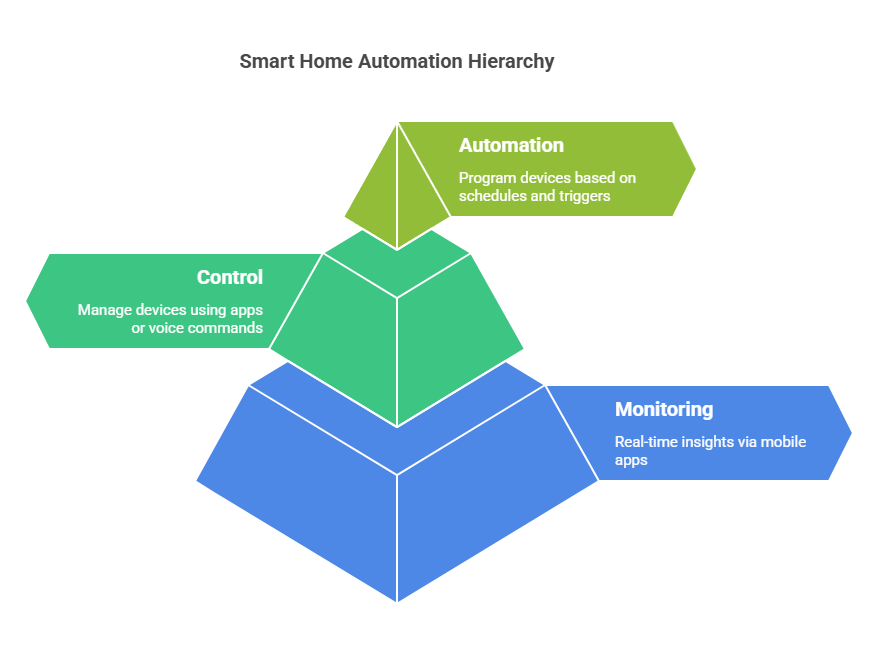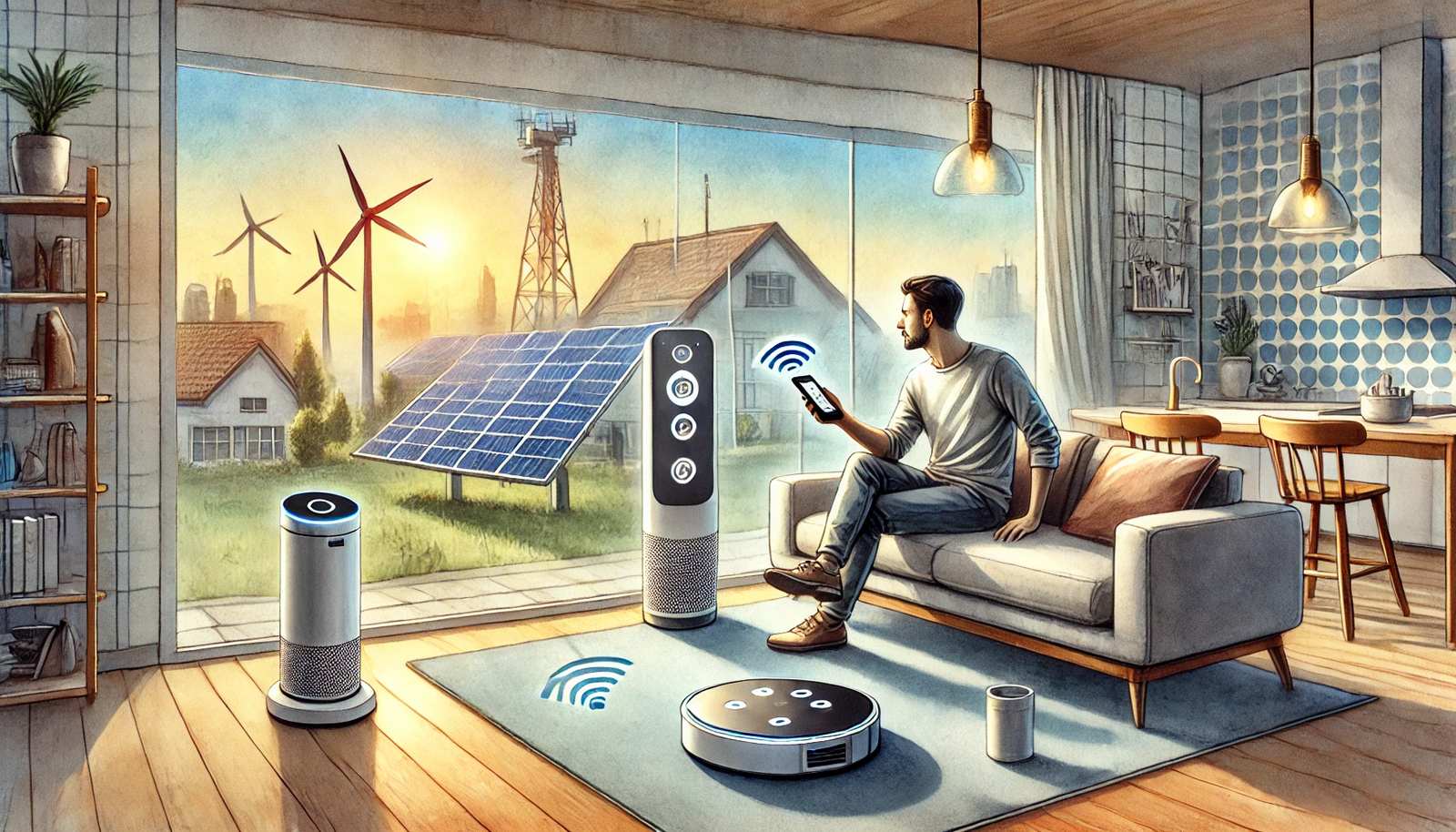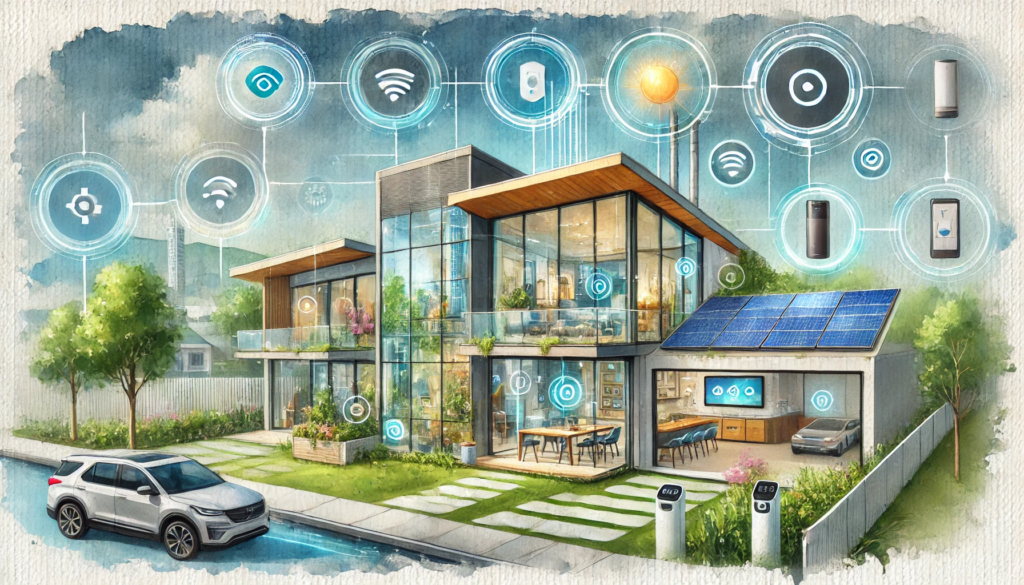Imagine walking into your home after a long day, and the lights automatically adjust to your preferred brightness, the thermostat sets the perfect temperature, and your favorite playlist starts playing—all without lifting a finger. This isn’t science fiction; it’s the reality of smart home automation.
Smart home automation is revolutionizing the way we interact with our living spaces, offering unprecedented convenience, efficiency, and security. As technology advances, more homeowners are embracing smart devices that streamline daily routines and create personalized experiences.
In this comprehensive guide, we’ll explore the essentials of smart home automation, including how it works, its key components, and why it’s becoming an integral part of modern living.
1. What is Smart Home Automation?
Smart home automation refers to the integration of internet-connected devices that allow homeowners to remotely monitor and control various aspects of their living space. These systems connect everyday appliances—such as lighting, heating, security cameras, and entertainment units—to a central hub or cloud platform, enabling seamless communication and automated responses.
At its core, smart home technology is designed to enhance convenience, improve energy efficiency, and provide enhanced security. Whether it’s adjusting a thermostat from a smartphone, receiving security alerts while away, or setting routines that turn off lights at bedtime, automation makes daily life more effortless and intuitive.
How It Integrates with Daily Life
- Convenience: Automate daily tasks like turning on lights, adjusting the thermostat, or locking doors.
- Energy Efficiency: Optimize power consumption with smart thermostats and energy-efficient lighting.
- Security: Monitor your home remotely with smart cameras, doorbells, and alarm systems.
- Personalization: Customize settings to fit individual preferences, such as scheduling morning routines or setting mood lighting for movie nights.
2. Key Components of Smart Home Automation
To build an efficient smart home system, it’s essential to understand the fundamental components that make automation possible.
Smart Devices
Smart devices are the building blocks of any automated home. These include:
- Smart Lights: LED bulbs that can be dimmed, color-adjusted, or scheduled.
- Smart Thermostats: Learn temperature preferences and optimize heating and cooling.
- Smart Security Systems: Cameras, doorbells, and motion sensors that provide real-time monitoring and alerts.
- Smart Appliances: Refrigerators, ovens, and even coffee makers that can be remotely controlled or scheduled.
Central Hub
A central hub acts as the “brain” of the smart home, connecting and coordinating all devices. Some smart home setups rely on dedicated hubs (like Samsung SmartThings or Apple HomeKit), while others use voice assistants (such as Amazon Alexa or Google Assistant) as their control center.
Network Protocols
Smart devices communicate through various network protocols, ensuring seamless connectivity and responsiveness. The most common protocols include:
- Wi-Fi: Offers fast, direct internet access but can strain bandwidth with multiple devices.
- Bluetooth: Ideal for short-range connections, often used for smart locks and speakers.
- Zigbee & Z-Wave: Low-power, mesh networks that connect multiple devices efficiently, reducing internet congestion.
User Interface
To control smart devices, users rely on intuitive interfaces such as:
- Smartphone Apps: Dedicated apps allow homeowners to monitor and adjust devices from anywhere.
- Voice Assistants: Amazon Alexa, Google Assistant, and Apple Siri enable hands-free control.
- Touch Panels & Displays: Smart home dashboards provide a centralized view of all connected devices.
Understanding these components is the first step toward creating a fully integrated and efficient smart home ecosystem.
3. How Smart Home Automation Works
Smart home automation operates on three key levels: monitoring, control, and automation. These elements work together to create a seamless and intuitive home experience. 
Monitoring
Monitoring allows homeowners to check the status of their smart devices remotely. Whether it’s viewing a live feed from a security camera, checking if the garage door is open, or monitoring energy consumption, smart home systems provide real-time insights through mobile apps or dashboards.
📌 Examples:
- Viewing security camera footage from a smartphone.
- Checking indoor temperature and humidity levels.
- Receiving alerts for unusual activity, such as a door being opened unexpectedly.
Control
Control involves managing smart home devices from anywhere using smartphone apps, voice assistants, or physical controls like smart switches. With a simple tap or voice command, homeowners can adjust settings, activate devices, or create custom scenarios.
📌 Examples:
- Adjusting the thermostat while on the way home.
- Turning off all lights with a single voice command.
- Locking doors remotely for added security.
Automation
Automation takes smart home technology to the next level by programming devices to operate based on schedules, conditions, or triggers. Instead of manually controlling devices, users can set up routines that make their homes more efficient and responsive.
📌 Examples:
- Smart lights turning on at sunset and off at bedtime.
- A thermostat adjusting temperature based on occupancy.
- A security system activating when all household members leave.
By combining monitoring, control, and automation, smart homes provide an effortless, hands-free living experience tailored to each homeowner’s lifestyle.
4. Benefits of Smart Home Automation

Smart home automation offers numerous advantages that go beyond convenience. From energy savings to enhanced security, here’s why more homeowners are embracing smart technology.
1. Convenience
One of the biggest appeals of smart home automation is the ability to manage multiple aspects of the home from a single device. Whether using a smartphone, tablet, or voice assistant, homeowners can control lights, thermostats, appliances, and security systems with ease.
📌 Examples:
- Adjusting all lighting settings without moving from the couch.
- Creating a morning routine that gradually turns on lights and starts the coffee maker.
- Using voice commands to control entertainment systems.
2. Energy Efficiency
Smart devices help reduce energy consumption by optimizing heating, cooling, and lighting usage based on real-time data and user habits. This leads to lower electricity bills and a more eco-friendly home.
📌 Examples:
- Smart thermostats adjusting temperature when no one is home.
- Motion-sensor lights turning off in unoccupied rooms.
- Smart plugs cutting power to idle appliances to reduce standby energy usage.
3. Enhanced Security
Security is a top priority for many homeowners, and smart home automation enhances protection with remote monitoring and real-time alerts. Advanced security systems integrate cameras, door sensors, and alarms to provide 24/7 surveillance.
📌 Examples:
- Receiving instant notifications if a door or window is opened unexpectedly.
- Two-way audio on smart doorbells for safe interaction with visitors.
- Automated locks securing the house at a set time each night.
4. Accessibility
For elderly and disabled individuals, smart home automation can provide greater independence and accessibility. Voice control, automated routines, and remote monitoring make daily tasks easier and safer.
📌 Examples:
- Voice-activated lights eliminating the need for switches.
- Automated medication reminders and alerts.
- Smart door locks enabling caregivers to enter securely.
5. Personalization
Every home is unique, and smart home technology allows for customized experiences based on individual preferences. Homeowners can tailor settings to create an environment that suits their lifestyle.
📌 Examples:
- Smart lighting adjusting color temperature for relaxation or focus.
- Personalized climate control for different rooms or family members.
- Home entertainment systems setting the perfect movie-night ambiance automatically.
With these benefits, smart home automation isn’t just about convenience—it’s about enhancing comfort, security, and efficiency while making everyday life more enjoyable.
5. Challenges and Considerations
While smart home automation offers numerous benefits, there are several challenges and considerations that homeowners should keep in mind before fully integrating these technologies into their daily lives.
1. Cost
The initial investment in smart home technology can be significant, especially when purchasing multiple devices or installing a whole-home system. However, long-term savings on energy bills and potential insurance discounts can help offset the upfront costs.
📌 Considerations:
- High-end smart systems can cost thousands of dollars.
- Some devices, like smart thermostats and lighting, can lead to energy savings over time.
- DIY vs. professional installation affects overall costs.
2. Compatibility
Not all smart home devices are compatible with each other, making seamless integration a potential challenge. Different brands use varying communication protocols like Wi-Fi, Zigbee, and Z-Wave, which may require additional hubs or software to work together.
📌 Considerations:
- Choosing an ecosystem (Google Home, Amazon Alexa, Apple HomeKit) helps ensure compatibility.
- Some devices require additional bridges or hubs.
- Future-proofing by investing in widely adopted technologies.
3. Privacy & Security
Smart home devices collect and transmit personal data, raising concerns about cybersecurity and privacy. Unsecured devices may be vulnerable to hacking, leading to unauthorized access to home networks.
📌 Considerations:
- Use strong, unique passwords for smart home accounts.
- Enable two-factor authentication where possible.
- Regularly update firmware and software to patch vulnerabilities.
- Invest in devices from reputable manufacturers with strong security measures.
4. Learning Curve
For first-time users, setting up and optimizing a smart home system can be overwhelming. Understanding device features, automation possibilities, and troubleshooting methods may require time and effort.
📌 Considerations:
- Start with a few essential devices and expand gradually.
- Take advantage of manufacturer guides, forums, and support services.
- Experiment with automation to find what works best.
Despite these challenges, careful planning and research can help homeowners maximize the benefits of smart home automation while mitigating potential downsides.
6. The Future of Smart Home Automation
As technology continues to evolve, smart home automation is expected to become even more advanced, accessible, and intelligent. Here are some key trends shaping the future of smart homes:
1. Artificial Intelligence & Machine Learning
Future smart home systems will become more intuitive and adaptive, learning user habits to automate functions without manual programming. AI-driven automation will provide predictive energy management, personalized routines, and advanced security features.
📌 Example:
- AI-powered thermostats automatically adjusting based on weather and occupancy patterns.
2. Integration with Smart Cities & IoT Expansion
Smart homes will increasingly integrate with smart city infrastructure, optimizing energy consumption and improving overall efficiency. Enhanced IoT connectivity will enable seamless communication between homes, appliances, and external services.
📌 Example:
- Smart grids adjusting power supply based on household energy consumption.
3. Voice & Gesture Control Advancements
While voice assistants are already popular, gesture-based controls and more sophisticated voice recognition will make interactions even more natural and hands-free.
📌 Example:
- Waving a hand to turn off lights or adjust TV volume.
4. Enhanced Security & Privacy Measures
As cyber threats increase, stronger encryption, biometric authentication, and decentralized data storage will improve security and protect user privacy.
📌 Example:
- Facial recognition for home access instead of traditional keys.
5. Sustainable & Energy-Efficient Smart Homes
The future of smart homes will focus on sustainability, incorporating solar power integration, automated water conservation systems, and AI-driven energy management.
📌 Example:
- Smart irrigation systems that adjust watering schedules based on weather forecasts.
These innovations will make smart home automation more efficient, secure, and user-friendly, further solidifying its role in modern living.
Conclusion
Smart home automation is revolutionizing the way we interact with our living spaces. By integrating smart devices, automation, and AI-driven systems, homeowners can enjoy greater convenience, energy efficiency, security, and personalization.
Key Takeaways:
✔ Smart home automation allows users to monitor, control, and automate their home environment.
✔ Key components include smart devices, hubs, network protocols, and user interfaces.
✔ Benefits range from convenience and energy savings to enhanced security and accessibility.
✔ Challenges include cost, compatibility, security risks, and the learning curve.
✔ The future promises AI-driven automation, improved security, and sustainable smart living.
As technology continues to evolve, smart homes will become even more intelligent, connected, and tailored to individual lifestyles. Whether you’re starting small with a smart thermostat or planning a fully automated home, the possibilities are endless.
Frequently Asked Questions (FAQ)
1. What is the main benefit of smart home automation?
Smart home automation provides a range of benefits, including increased convenience, energy efficiency, enhanced security, and personalization. By automating routine tasks and remotely controlling devices, you can save time, reduce utility costs, and improve the overall safety and comfort of your home.
2. How does smart home automation work?
Smart home automation works by connecting internet-enabled devices (like lights, thermostats, and security cameras) to a central hub or platform, which allows you to monitor, control, and automate these devices remotely through a smartphone app, voice commands, or predefined schedules.
3. Are smart home devices compatible with each other?
Not all smart home devices are universally compatible. However, most devices within a specific platform (e.g., Google Home, Amazon Alexa, or Apple HomeKit) work seamlessly together. To ensure compatibility, it’s important to choose devices that support the same network protocols (e.g., Wi-Fi, Zigbee, or Z-Wave).
4. Can I control my smart home remotely?
Yes! One of the key features of smart home automation is the ability to control devices remotely. Whether you’re at work or on vacation, you can adjust your thermostat, turn off lights, or even check the security cameras through an app on your smartphone or tablet.
5. Are smart home systems secure?
Smart home systems can be vulnerable to security risks, especially if not properly set up or maintained. To ensure safety, make sure to use strong passwords, enable two-factor authentication, regularly update firmware, and choose devices from reputable brands with strong security protocols.

